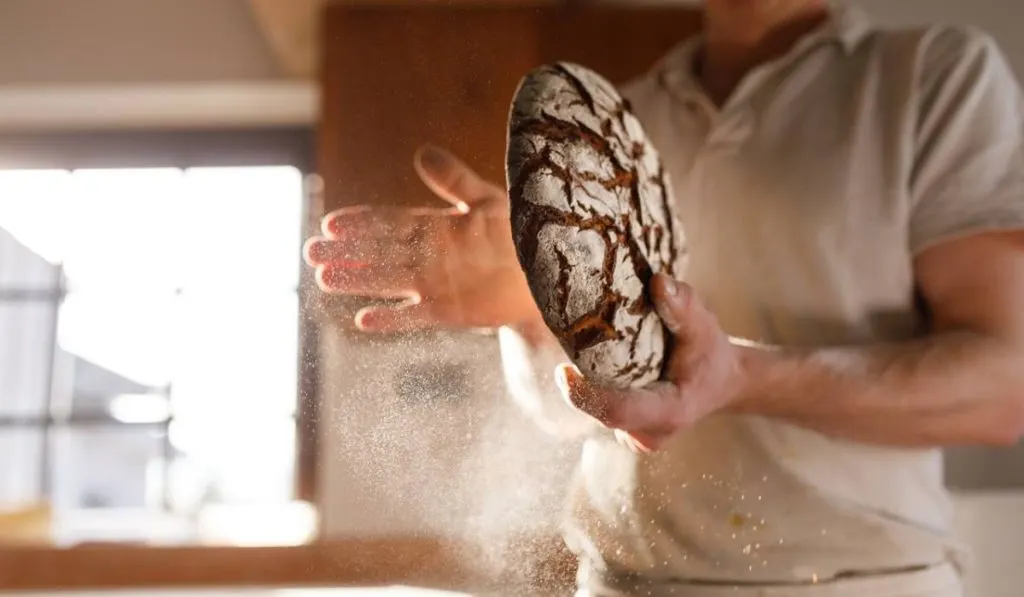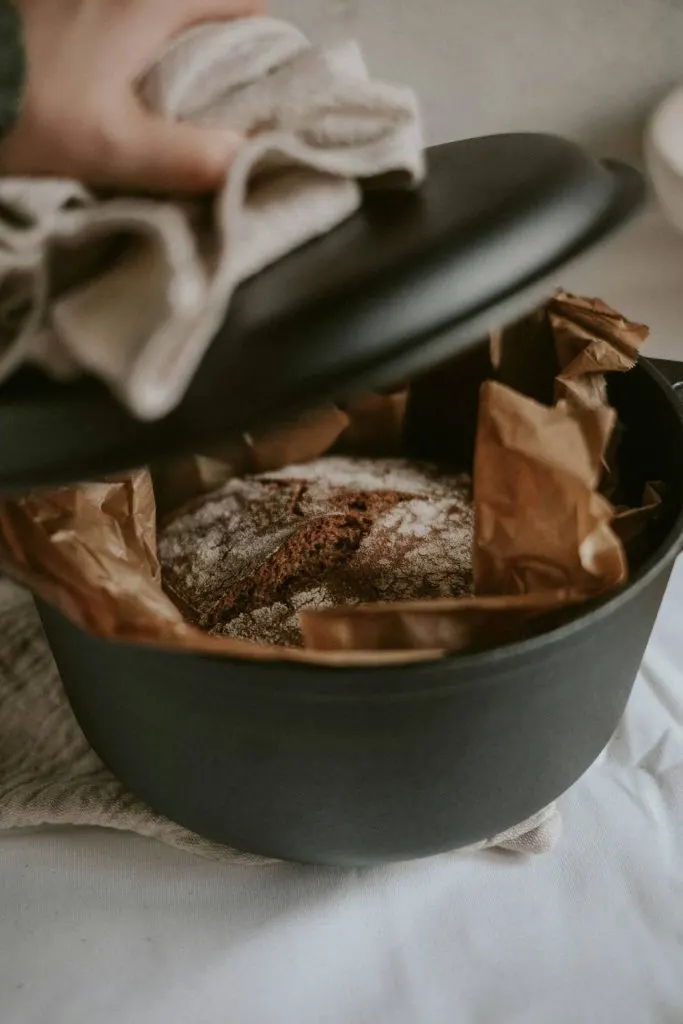
Dive into the sumptuous realm of chocolate sourdough bread, where the rich, comforting taste of chocolate meets the tangy complexity of traditional sourdough. Ever puzzled over how to meld these distinct flavors harmoniously? You’re not alone. But get ready—this guide will take you on a baking adventure that not only hones your skills but also delights your palate.
TL;DR
- Learn the secret to creating the perfect blend of chocolate and sourdough.
- Discover essential tips for enhancing the flavor and texture of your bread.
- Explore innovative ways to use chocolate sourdough bread in various dishes.
- Understand the health benefits and joy of baking your own artisan bread.
- Get answers to common questions and troubleshoot your baking process.
Mastering the Craft of Chocolate Sourdough Bread
Crafting the perfect chocolate sourdough bread is a rewarding endeavor that marries the rich flavors of chocolate with the tangy complexities of sourdough. This journey requires a thorough understanding of both flavor balance and the nuances of dough fermentation. Here, we will delve deep into the intricacies of ingredient selection and fermentation processes to help you create a loaf that is as delightful to eat as it is beautiful to behold.
Selecting the Right Ingredients
The selection of high-quality ingredients is crucial in creating an exceptional loaf of chocolate sourdough bread. Each component plays a significant role in the final taste, texture, and appearance of your bread.
- Chocolate: Opt for a premium dark chocolate with at least 70% cocoa content. This not only ensures a deep, rich chocolate flavor that complements the sourdough but also contributes to a more complex aroma and depth in the bread’s profile.
- Chocolate Form: Consider the form of chocolate—chips, chunks, or grated. Chips and chunks are ideal for a gooey, melty texture, while grated chocolate distributes more evenly, imparting a subtle chocolate flavor throughout the loaf.
- Sourdough Starter: A robust, active starter is essential. Your starter should be well-maintained, showing vigorous activity and doubling in size within 4 to 6 hours after feeding.
- Hydration Level: Adjust the hydration of your starter depending on the desired sourness level; a wetter starter tends to produce a tangier loaf.
- Flour: Use a strong bread flour with a high protein content, typically around 12-14%. This helps in building a good gluten network that can support the added weight and texture of the chocolate.
- Whole Grains: Mixing in a small proportion of whole wheat or rye flour can enhance the flavor complexity and improve the nutritional profile of your bread.
- Additional Ingredients:
- Salt: Essential for flavor enhancement and gluten structure.
- Sugar: Optional, to balance the bitterness of dark chocolate and enhance the browning of the crust.
Perfecting Fermentation
Fermentation is the soul of sourdough bread making. It’s vital to manage this process carefully, especially when incorporating ingredients like chocolate, which can affect the behavior of your dough.
- Initial Mixing: Incorporate the chocolate into the dough during the final stages of mixing to prevent it from interfering with gluten development.
- Bulk Fermentation:
- Duration: Extend the usual bulk fermentation time by 1-2 hours, depending on the dough’s progress. This allows flavors to develop more fully and can help the dough structure to integrate the fat from the chocolate.
- Temperature: Maintain a dough temperature around 76-78°F (24-26°C) to optimize yeast activity.
- Stretch and Folds: Perform additional stretch and folds to help strengthen the dough. This is especially important when working with the added richness of chocolate.
- Proofing:
- Final Rise: Allow for a slightly longer proofing time if the dough seems sluggish. This can be due to the fat content from the chocolate slowing down yeast activity.
- Refrigeration: Consider a cold overnight proof to enhance flavor complexity and make the dough easier to handle and score before baking.
- Baking Adjustments:
- Steam: Introduce steam during the initial phase of baking to achieve an artisan crust. Remove the steam source halfway through to allow the crust to dry and crisp up.
- Temperature: Bake at a slightly lower temperature if using a high quantity of chocolate to prevent burning.
Troubleshooting Common Issues
- Dough Too Tight or Dry: Adjust hydration levels. Chocolate can absorb moisture, so you might need to increase the water content of your dough.
- Flavor Too Bitter: Balance the bitterness with a small amount of sugar or choose a chocolate with a lower cocoa percentage.
- Poor Oven Spring: Ensure your fermentation times are sufficient, especially during bulk fermentation. Also, verify that your starter is at peak activity before use.
By following these detailed guidelines and paying close attention to the quality of your ingredients and the nuances of fermentation, you’ll be well on your way to baking a sensational loaf of chocolate sourdough bread that is sure to impress.
Enhancing Flavor and Texture of Chocolate Sourdough Bread
When crafting chocolate sourdough bread, the goal is to create a harmonious blend of flavors and textures that elevate the traditional sourdough experience. This section offers detailed strategies for infusing your loaf with intricate flavors and achieving a desirable crumb structure.
Experimenting with Complementary Flavors
Integrating complementary flavors into your chocolate sourdough can transform an ordinary loaf into an extraordinary culinary delight. Here are some suggestions to enhance the complexity and appeal of your bread:
- Spices and Extracts:
- Cinnamon: Adds warmth and spice, which complements the richness of chocolate.
- Vanilla Extract: Imparts a sweet, aromatic flavor that softens the intensity of dark chocolate.
- Cardamom: Offers a slightly sweet, floral note that pairs well with chocolate.
- Chili Powder: A pinch can enhance the chocolate’s depth, adding a subtle kick.
- Citrus Zest:
- Orange Zest: Brightens the chocolate flavor, adding a refreshing contrast to the deep, earthy tones.
- Lemon Zest: Introduces a tangy note, which can cut through the richness of the bread.
- Nuts and Seeds:
- Walnuts or Pecans: Introduce a crunchy texture and nutty flavor that complements both sourdough and chocolate.
- Sesame Seeds: Sprinkle on top before baking for a toasty flavor and added crunch.
Achieving the Perfect Crumb
The texture of your chocolate sourdough is as important as its taste. Aim for a bread that is soft with a chewy crust, achieved through precise moisture control and baking techniques.
- Moisture Management:
- Steam in the Oven: Use ice cubes or a preheated cast iron pan with water to generate steam during the initial baking phase. This helps the dough expand freely before the crust sets, leading to a softer interior and a chewier crust.
- Hydration Adjustments: Depending on the type of chocolate used (chips, chunks, or cocoa powder), you may need to adjust the hydration level of your dough. Chocolate can affect how the dough absorbs and retains moisture.
- Baking Techniques:
- Oven Temperature: Bake at a high temperature initially to set the crust, then lower slightly to allow the interior to cook through without burning the chocolate.
- Baking Surface: Use a baking stone or a preheated Dutch oven to provide a consistent, radiant heat that helps in achieving a better rise and crust.

Creative Culinary Applications
Chocolate sourdough bread’s versatility makes it a unique addition to both sweet and savory dishes. Explore these creative applications to delight your palate:
Breakfast and Brunch Delights
- Chocolate Sourdough French Toast:
- Ingredients: Thick slices of chocolate sourdough, eggs, milk, vanilla, and cinnamon.
- Preparation: Dip the bread in a rich custard mixture and pan-fry until golden. Serve with mascarpone cheese and fresh berries for a luxurious treat.
- Decadent Chocolate Bread Pudding:
- Setup: Cube the chocolate sourdough and soak in a mixture of cream, chocolate, and eggs.
- Bake: Until the mixture is set and the top is crusty. Serve with a drizzle of caramel sauce.
Savory Pairings
- Gourmet Grilled Cheese:
- Combination: Aged cheddar or Gruyère melted between slices of chocolate sourdough.
- Serve with: Tomato soup for a comforting meal with a twist.
- Chocolate Sourdough and Brie Sandwich:
- Ingredients: Thinly sliced brie and a spicy fruit chutney spread between slices of lightly toasted chocolate sourdough.
- Serving Suggestion: This sandwich pairs well with a crisp salad or tangy pickles.
By incorporating these strategies and ideas, you can elevate your chocolate sourdough bread from a simple baked good to an impressive culinary creation that excites the senses and inspires creativity in the kitchen.
The Joy of Baking Chocolate Sourdough Bread
Baking chocolate sourdough at home brings numerous benefits, from the satisfaction of creating something with your own hands to knowing exactly what goes into your food—no unwanted preservatives or artificial ingredients.
Health Benefits
Sourdough fermentation not only enhances the bread’s flavor but also increases the availability of important nutrients and makes the bread easier to digest. Adding dark chocolate, rich in antioxidants, enhances these health benefits, making your indulgent loaf a bit healthier.
Conclusion
Baking chocolate sourdough bread is a delightful journey that intertwines culinary art with personal satisfaction. Through understanding the balance of flavors, mastering fermentation techniques, and exploring innovative uses for your bread, you create more than just a loaf; you craft an experience.
Each slice offers a rich blend of deep chocolate and tangy sourdough—a testament to the joy and health benefits of homemade artisan baking. Embrace the process, enjoy the results, and share the love of baking with every bite you take. This isn’t just baking—it’s a pathway to a richer, more flavorful life.
Frequently Asked Questions
What’s the best chocolate to use in sourdough bread?
Opt for a high-quality dark chocolate with a cocoa content of 70% or higher for best results.
Can I use a regular yeast dough instead of sourdough?
While you can use yeast, sourdough adds a depth of flavor and texture that yeast cannot replicate.
How do I store chocolate sourdough bread?
Wrap the bread in a clean, dry cloth and store it at room temperature. It can also be frozen for longer storage.
Is chocolate sourdough bread suitable for vegans?
Yes, if you use vegan chocolate and ensure no other animal-derived ingredients are used, your chocolate sourdough bread can be vegan-friendly.
How do I know when my dough is perfectly fermented?
The dough should almost double in size and retain a slight indentation when gently poked.
Join Us and Transform >
Don’t Be an Amateur! Master the Art of Sourdough Bread!




Leave a comment